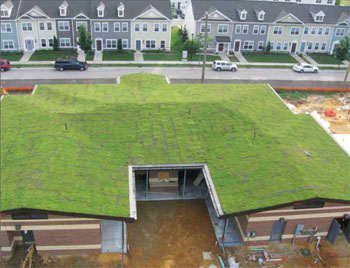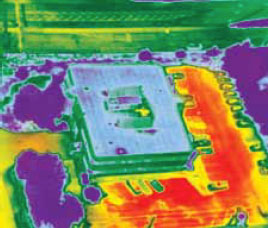Cooling Off
Learning Objectives:
- Explain the ill effects of urban heat islands and how to mitigate them.
- Describe the properties of cool roofing products and how they work to decrease rooftop temperatures.
- Identify key installation principles for cool roofing systems.
- Describe the benefits of green, planted roofs.
Credits:
Directly causing elevated urban temperatures, the urban heat island (UHI) effect has not only been identified as increasing peak summertime A/C electrical demand by 5 to 10 percent, but UHI has been documented to increase smog, adversely affect health and compromise water quality.
Defined as densely populated areas where temperatures range between 2 F and 8 F warmer than surrounding less urban areas, UHI is a force to contend with.
“Three factors have been identified as the primary causes of UHIs: the reduction of vegetation, such as trees, shrubs and grass; a concentration of dark, energy-absorbing roof surfaces; and an increase in dark, energy-absorbing surfaces for roads and parking lots,” explains Drew Ballensky, general manager, Duro-Last Roofing, Iowa City.
Essentially, large areas of rooftop surfaces and pavement compromise the environment’s ability to release the sun’s radiation which is absorbed throughout the day. Ideally, natural surfaces - i.e., vegetation and soil - naturally transform the radiation into water vapor through the process of evapotranspiration and cool the surrounding air. However, in heavily built-up areas, non-reflective and water-resistant construction materials impede this process, thereby absorbing high percentages of radiation which is then released as heat, as opposed to cooling water vapor.
To more clearly establish the extent to which urbanization is compromising a city’s ability to naturally cool itself, the percentage of hard surfaces in most U.S. cities is approximately 60 percent, with roadways making up between 35 percent and 45 percent, and rooftop surfaces accounting for around 16 percent, according to Yves Baudouin, director of graduate studies, Department of Geography, University of Quebec at Montreal. However, Lawrence Berkeley National Laboratory (LBNL) puts these rooftop numbers even higher at between 20 percent and 25 percent of urban land cover.
 |
|
Photo courtesy of BRPH This green vegetated roof at the Warriors in Transition Complex - Soldier Family Assistance Center in Fort Eustis, Va., helps mitigate the urban heat island effect amongst other benefits. |
“The urban heat island effect is problematic because it makes the warmest times of the year even hotter. This increases human discomfort, drives air conditioning usage higher, generates more greenhouse gas emissions from increased electricity production, places more strain on the electricity grid during peak electricity periods and worsens air quality as increasing temperatures catalyze the formation of ground-level ozone,” explains Benjamin Mandel, graduate student research assistant, heat island group, environmental energy technologies division, Lawrence Berkeley National Laboratory, Berkeley, Calif.
This rise in temperature also compromises water quality as excess heat from pavement and rooftops is then transferred to the stormwater draining into the streams, rivers, ponds and lakes, says Andrea Denny, local climate and energy program lead, U.S. Environmental Protection Agency (EPA), Washington, D.C.
Of greater concern are the adverse health effects stemming from UHIs, particularly targeting the elderly and the young. These include respiratory problems, heat stroke, exhaustion and heat cramps. In fact, according to the Centers for Disease Control and Prevention, excessive heat exposure contributed to more than 8,000 deaths from 1979 to 2003.
With the price tag and dangers of UHIs well established, designers and building owners are actively taking steps to mitigate these ill effects. As the most effective strategy, “cool roofs” are frequently a go-to solution for today’s building projects. In fact, LBNL estimates that converting 80 percent of the nation’s commercial buildings to cool roofs would reduce 6.23 metric tons of CO2 emissions. Practically speaking, this is the equivalent of annual emissions released by 1.2 million conventional cars.
“Cool roofing products are made of highly reflective and emissive materials that release absorbed heat and can remain approximately 50 F to 60 F cooler than traditional materials during peak summer weather,” says Denny. “A cool roof transfers less heat to the building below, so the building stays cooler and uses less energy for air conditioning.”
Approximating these AC savings as falling between 10 percent to 30 percent, Jessica Clark, LEED AP, marketing liaison, Cool Roof Rating Council, Oakland, Calif., also points out that cool roofing’s ability to limit temperature fluctuation also boosts the system’s longevity and decreases maintenance costs.
How it Works
To better understand how cool roofing products work, as compared to conventional dark roofing, performance is characterized by solar reflectance, also called albedo, and thermal emittance.
To assess solar reflectance, a material’s ability to reflect energy at each solar energy wavelength is measured, and then the weighted average of these values is calculated. Whereas traditional roofing offers a low solar reflectance of 5 percent to 15 percent, which means that they can absorb up to 95 percent of solar energy, cool roofing products offer a high solar reflectance of more than 65 percent. In both cases, radiation is reflected across the entire solar spectrum, but particularly in the visible and infrared wavelengths.
Thermal emittance is defined as the roofing surface’s ability, per unit area at a given temperature, to re-radiate heat that is absorbed.
“When exposed to sunlight, a surface with high emittance will reach thermal convenequilibrium at a lower temperature than a surface with low emittance because the high-emittance surface gives off its heat more readily,” explains Denny.
Combining these two metrics yields the Solar Reflectance Index, which is assigned a value from 0 to 100, the higher numbers signifying a more energy-efficient roof.
What’s important to understand is the fact that it’s the combination of these two values which will yield the best performing products. For example, according to the EPA’s “Reducing Urban Heat Islands: Compendium of Strategies on Cool Roofs” white paper, standard black asphalt roofs have high thermal emittance but low reflectance, so summertime temperatures can hit 165 F to 185 F. And while metallic roofs have high reflectance, their low thermal emittance will send the temperature to between 150 F and 165 F during the summer months. Meanwhile, cool roofing products, with both high reflectance and high emittance, will keep summertime temperatures between 110 F and 115 F.
Even more impressive is the potential collective effect of cool roofing systems. As estimated by a simulation conducted by researchers at Columbia University and Hunter College, a 50 percent adoption of cool roofs in New York City could result in a city-wide temperature reduction of 0.3 F, peaking at a 0.6 F reduction at 3 p.m.
Another LBNL study, commissioned by the U.S. Department of Energy (DoE) and the EPA, studied the air conditioning and peak electrical demand for a 100,000-square-foot retail facility in Austin, Texas. For one year, data was collected on the building’s original black rubber EPDM roof. The roof was then retrofitted with a white, reflective PVC roofing system, and AC and electrical loads were analyzed for a second year.
In comparing thermal and energy performance for the black roof and reflective roof, LNBL discovered AC savings of $7,200 for the white roof, based upon 2001 utility prices, and an estimated lifetime savings of between $62,000 and $71,000 - not including load curtailment and/or utility rebate programs - over the course of 13 years.
Another LBNL initiative involved modeling a propotype building in multiple cities to project the hourly heating and cooling loads for a conventional roof versus a cool roof during a typical year. The study found that states with hot climates - namely Arizona, New Mexico, Nevada - stood to benefit the most from cool roofs with calculated average annual savings of 7.69, 6.92 and 6.86 kWh/m2, respectively per conditioned roof area. In contrast, a cooler state like Minnesota would glean a cooling energy reduction of 4.17 kWh/m2 of conditioned roof area throughout the course of the year.











